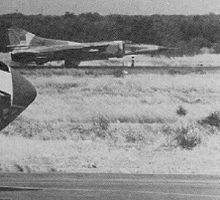Gouvernement d'Union Nationale de Transition
The Gouvernement d'Union Nationale de Transition ( GUNT for short , German: Transitional Government of National Unity ) is the name of a commission that was in power in Chad from 1979 to 1982. Its chairman and thus president of Chad was Goukouni Oueddei .
history
Emergence
The roots of GUNT lie in the situation that the Libyan-Chadian border war had created in Chad. After Hissene Habre , chairman of the anti-Libyan group FAN, allied with the then Chadian President Malloum in 1978, the pro-Libyan rebel group FAP under Goukouni Oueddei, supported by Libyan armed forces, launched an offensive . In 1978 the coalition of Oueddei and the Libyan ruler Gaddafi already showed cracks and there were clashes between rival groups. In 1979 the alliance between Habre and Malloum broke up and street fights broke out between Habres and Malloum's supporters in the Chadian capital of N'djamena . The resulting escalating and confusing situation in Chad led to an international peace conference in Kano, Nigeria . Pressure from Nigeria and France enabled the rivals Habre and Oueddei to share power in a government of national unity, the GUNT. Oueddei became President and Habre Minister of Defense .

fracture
Already on March 22, 1980, this coalition broke up due to fighting between Habres FAN and Oueddeis FAP in N'djamena, which had sparked, among other things, at the various positions on dealing with Libya. In the war that followed, Oueddei and the rest of the GUNT were able to achieve a clear victory against Habre's troops with Libyan support, who went into exile , but continued his fight against the GUNT.
Successes Habres
In 1981 there was a dispute between Gaddafi and Oueddei, as he accused Gaddafi with Ahmad Acyl, a high-ranking GUNT member, of planning the overthrow of Oueddei. As a result, Oueddei ordered the withdrawal of all Libyan troops from Chad. Gaddafi put this into practice. Habre took advantage of this weakening of the military presence of allies of the GUNT, starting from the east of the country, to conquer N'djamena and to depose the GUNT. Thus Habre became the new President of Chad.
GUNT offensive
After this defeat, Oueddei collected the remains of the GUNT with Libyan help, so that they again became a serious party in the conflict. After Habre followed a rather passive course in the first time of his presidency, he attacked the GUNT troops in the Tibesti region in December 1982 and January 1983 , but was repulsed. In June 1983 the GUNT launched an offensive that led to the conquest of the cities of Faya-Largeau , Abeche and Oum Chalouba .
Habres counteroffensive
With the support of the USA , France and the then Zaire, Habre was able to quickly build up a powerful army with which he was able to win a battle against the GUNT south of Abeche and then recaptured the areas previously conquered by the GUNT in quick succession.
Increased Libyan support
This defeat of the GUNT weakened the Libyan position of power in Chad, so that Gaddafi was forced to significantly expand Libyan engagement in Chad. With increased Libyan support, the GUNT was able to conquer Faya-Largeau again and force Habre to retreat to N'djamena. But as the conflict intensified, France was alarmed again and French intervention took place. France declared the 15th parallel as a border and did not tolerate any crossing by GUNT fighters. This resulted in a standstill, which was only interrupted by a minor attack by the GUNT on Ziguey, which was answered with violent air strikes from the French side. On April 30, 1984, French President Mitterrand and Gaddafi agreed to withdraw their respective troops from Chad, which France carried out on time, but Libya left some soldiers in northern Chad. The importance of the GUNT had decreased significantly due to internal disputes. Furthermore, GUNT fighters defected to Habre's government. To counteract this, a major offensive by Libyan and GUNT soldiers began on February 10, 1986 against Chadian positions south of the 15th parallel. But this offensive was repulsed.
Final decay
As a result, the GUNT was militarily defeated and in 1986 Oueddei no longer took part in diplomatic talks on the conflict. In 1986 the alliance between GUNT and Libya broke up and there was fighting between the two camps, which ended in the annihilation of the GUNT and the arrest of Oueddeis.
Individual evidence
- ^ Transitional Government of National Unity (GUNT) - Chad | Terrorist Groups | TRAC. Retrieved May 22, 2018 .
- ^ A b Roger de Weck: Libya's defeat in Chad: Two strikes for Ghaddafi . In: ZEIT ONLINE . April 3, 1987 ( zeit.de [accessed on May 22, 2018]).
- ^ A b Erwin Brunner and Roger de Weck: Barrage on the Tibesti . In: ZEIT ONLINE . August 19, 1983 ( zeit.de [accessed May 22, 2018]).
- ↑ "He is a bully, but also a rabbit's foot" . In: Der Spiegel . tape 33 , August 15, 1983 ( spiegel.de [accessed May 22, 2018]).
- ↑ James Brooke: CHAD FINDS UNITY IN WAR WITH LIBYA . ( nytimes.com [accessed May 22, 2018]).

